Text
Colorful Questions: A Candy Land Modified Board Game
Candy Land Evaluation
Due to the simplicity of the game, there are very few mechanics in Candy Land compared to other board games such as Life or Risk. The mechanics found in Candy Land are the player pieces, the spaces on the board, the cards, and the shortcuts that connect two spaces. Some cards may have two colors displayed on them, rather than just one. There are also wildcards found within the game. These wildcards have pictures of candy on them that correspond to the same picture on a space on the board. Shuffling is another mechanic of the game, as the rules require the cards to be shuffled before players begin to draw.
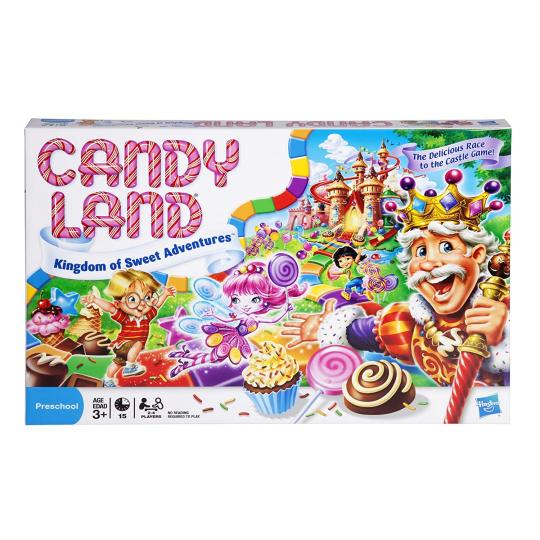
The limited amount of mechanics makes the dynamics of Candy Land very simple as well. The random element of which cards are drawn by the players creates the dynamic of players being in advantageous or disadvantageous positions on the board. One player may draw a double color card, which enables them to move the next two spaces of that color. Another player may only draw a single color card, which causes them to remain behind. Because the cards are shuffled, there is no way to tell which player has the best chance of winning the game. Drawing a wildcard makes the player teleport to wherever that candy is on the board, which could be far ahead or behind them.
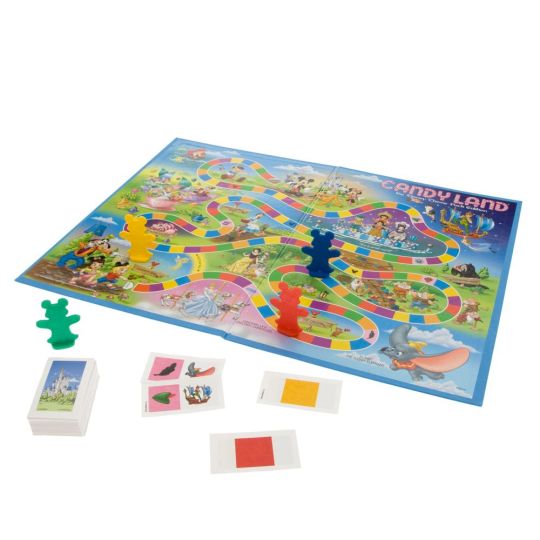
Candy Land Let’s Play Video
youtube
Video created by one of our group members.
For our game Colorful Questions, we modified a couple of mechanics in Candy Land to cater more towards older players. Instead of drawing a card to move, a die is rolled. The color that the player lands on prompts them to draw a card from the deck that corresponds to the color. These cards contain a question that the player must share the answer with the other players. If the player chooses not to answer, they must face a penalty and move backwards. Our intention for implementing these mechanics is to encourage a more social aspect to the game with player-to-player interaction. Players also have some choice in their progression, by either answering the question or willingly accepting the penalty. We want the players to feel more involved with the game, as well as using the game to get to know the other players more. It could be best described as a “party game.”

Candy Land Evaluation
Rules
Objective
Reach the end of the path by answering questions, and answer the ultimate question to win!
Number of Players
2-4 players
What You Need to Play
Player pieces, one die, question cards, and the board
Instructions
All players begin on the first space at the top of the question mark.
Determine who goes first by rolling the die, whoever has the highest number goes first!
The first player starts the game by rolling the die and moving the number of spaces by the number on the die.
The player then draws a question card from the appropriate color pile that matches the color of the space they landed on.
The player must share their answer the question on the card aloud to the other players to remain on the space they rolled, however, not answering the question will send the player back to the space they were on at the start of their turn.
Landing on a black space will also put the player back to the space they were on at the start of their turn. The player should not take a card if they failed to answer and are moved back.
After the player has either answered the question or moved back spaces for not answering the question, the next player clockwise from them is next to have their turn.
The player that lands on the last space of the question mark must answer the ultimate question. The question is decided by and asked by the person to the player’s left. If they answer it, they win the game. If they do not, they fail their interrogation and must go back to the Starting space.
If you should run out of cards, reshuffle and continue play!
Candy Land Rule Sheet
Colorful Questions Let’s Play Video
youtube
0 notes
Text
Royals Card Game
Objective:
The objective of the game is to try and get rid of all the cards in your hand while getting and keeping the King and/or Queen as the last card in your hand.
Downloadable Rulesheet:
Rulesheet
Images and Explanation:

What you’ll need:
You’ll need a standard deck of cards and 3-5 players.
Setting up the Game:
-Leave one King and Queens in the deck
-Shuffle the deck
-Dealer will deal out the entire deck among players.
Playing the Game:
-At the start of the game all players must remove all pairs from their hands and place it on the table in front of them

-The player to the left of the dealer is first, they must then take a card from the hand of the player to their left and place any new pairs down
-The next player is the player who just had their card taken and they will then repeat the process by taking a card from the person to their left.
-The game continues until all cards are removed from your hand or you hold the King and/or Queen
Wildcards:
-Jacks can be played when another player attempts to take your card, you can play it to force them choose another card rather than the one they were initially going to take.
-Jokers can be played at any time, when played the player that holds the King must hand it to the player that used the Joker.

Winning:
The winning conditions of this game are to have your last card either be the King or Queen, thus making you a Royal. There can be two winners in this situation.

Alternatively, if you hold both the King AND Queen as your last two cards, you are the sole winner.

If you run out of cards without holding a King or Queen, or the other players complete the above objectives, you lose.
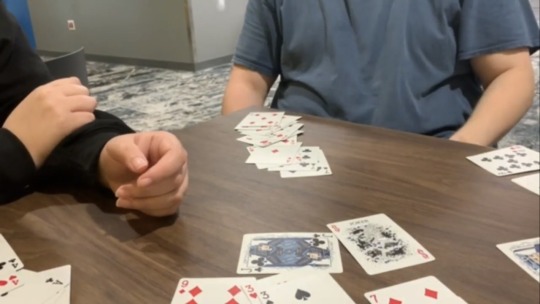
There is no score to be kept.
Video Gameplay:
youtube
0 notes
Text
FNAF: Dark Rooms Paper Prototype
Five Nights at Freddy’s, or FNAF, is a jump scare horror game in which the player’s goal is to survive the night. In the Dark Room level of the game the player needs to stop the plush on the “X” before time tunes out or they are attacked. The player is blindfolded and only has 30 seconds to achieve this goal and they can only go by sound cues and can only look up four times.

https://freddy-fazbears-pizza.fandom.com/wiki/Plushtrap#Gallery

https://freddy-fazbears-pizza.fandom.com/wiki/Nightmare_Balloon_Boy
Five Nights at Freddy’s VR: Help Wanted Concept
High Concept
The Five Nights at Freddy’s horror finally arrives to virtual reality. Look around for the animatronics as you try to keep them from jump-scaring you.
Features
● Utilizes first-person POV with a VR headset
● 40 minigames that draw upon the loved originals as well as introducing new, unique content
● The game is single-player and is meant to be played alone
● One of the minigame mechanics involve the player being trapped in Freddy Fazbear’s Pizza with the job as nighttime security. The CCTV and flashlights will prove vital to keeping a visual of what may be lurking in the building
● Another minigame mechanic requires the player to fix the ventilation systems and damaged toys in Freddy Fazbear’s Pizza, all the while avoiding the terrifying animatronics
● Dark rooms force the player to react to the impending horror of an animatronic jumping at them from the pitch black
● Earn prizes at the Prize Counter and collect Faz-Tokens for even more exclusive rewards
● Confront the series-persisting characters such as Freddy and Foxy
Player Motivation
Players attempt to reach the end of the game without being jump-scared, which results in a “game over”.
Genre
Virtual reality survival horror with an emphasis on jump-scares.
License
This game acts as a continuation of the existing Five Nights at Freddy’s game series, with the reuse of characters and mechanics from those games. The previous games were extremely popular and successful, especially the original Five Nights at Freddy’s, which became a viral phenomenon.
Target Customer
Horror game lovers that enjoyed the previous Five Nights at Freddy’s games.
Competition
While it competes with other horror-based games such as Resident Evil 7: Biohazard and The Evil Within 2, this game focuses exclusively on jump-scares to emphasize the horror, rather than focusing too much on plot.
Unique Selling Points
● VR continuation of the Five Nights at Freddy’s series
● Test of player reaction time
● Horror based off of characters made for children
Target Hardware
Oculus Rift, HTC Vive, or Playstation VR
Design Goals
Scary: Pure horror and suspense is the main objective. There is no time to relax when playing this game, as every second allows the animatronics to get closer to their target.
Simple: The setting and plot of the game are very restricted. The objective is to not get jump-scared, and simplified controls allows for more focus on the gameplay mechanics.
Fast: With 40 minigames to go through, each one has a simple and fast goal. Either the player makes it out alive.. Or they don’t.
Characters
The main characters of the game are the antagonists that the player must face.
Mike Schmidt: This is the character that the player controls. He is in charge of the night shift security at Freddy Fazbear’s Pizza. He is not seen, since the game is in first person.
Glitchtrap: The main antagonist of the game. It is a brown rabbit sentient virus that merged with a beta-tester of a Freddy Fazbear game. The player must try to stop Glitchtrap from merging with them as well.
Freddy Fazbear: The bear that acts as the titular character of the series. He is a brown bear animatronic that wears a bow tie and a top hat.
Bonnie: A purple rabbit animatronic with a red bow tie and a guitar. He will kill any human that he sees during the night.
Foxy: A brown fox animatronic dressed up in pirate garb, including an eye patch and a hook for a hand.
Chica: A yellow chicken animatronic with a bib that says: “Let’s Eat!!!”.
Art Style Guide
POV
The POV of this game, in the Five Nights at Freddy’s 4 version, is in first person with the camera restricted to look straight forward. In the VR Help Wanted version, the game is still first person but with the use of the VR headset, the camera is not limited by movement.

https://freddy-fazbears-pizza.fandom.com/wiki/Hallway
Color
Coloring should be restricted to cool colors such as a deep blue or black. Light should only be used when activating the flashlight feature but even then, a limited amount of light should be shown on screen, contrasting with the dark setting. In Help Wanted, brown tiles are used on the walls and instead of a greyed out “X” it has been replaced with a red color to show more visibility. When the room is completely dark, devoid of the flashlight, only the window at the top shows a faint blue tint.
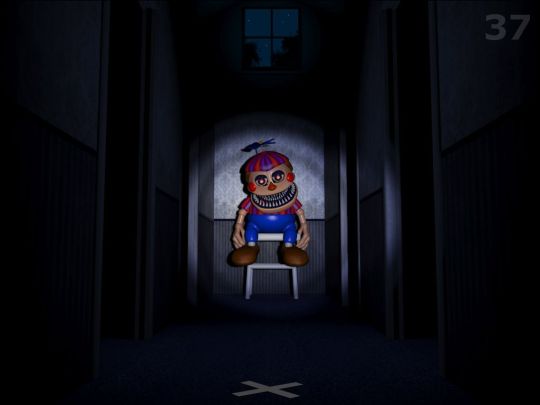
https://freddy-fazbears-pizza.fandom.com/wiki/Fun_with_Plushtrap?file=Nightmarebbonchair.jpg#Gallery
Composition
The hallway should lead into a one-point perspective, with both sides of the hallway being parallel to each other. In fact, the entire hallway should be symmetrical with only the enemy, Plushtrap or Nightmare BB, asymmetrical.
The setting of this game contains several rectangular geometric shapes such as the hallway itself, the window, and the side hallways. The only organic shape present is the enemy itself, however some parts of Nightmare BB’s design have repetitive shapes such as circles and triangles. The characters are short and designed to look more like a toy than an adult sized character.

https://freddy-fazbears-pizza.fandom.com/wiki/Plushtrap#Gallery
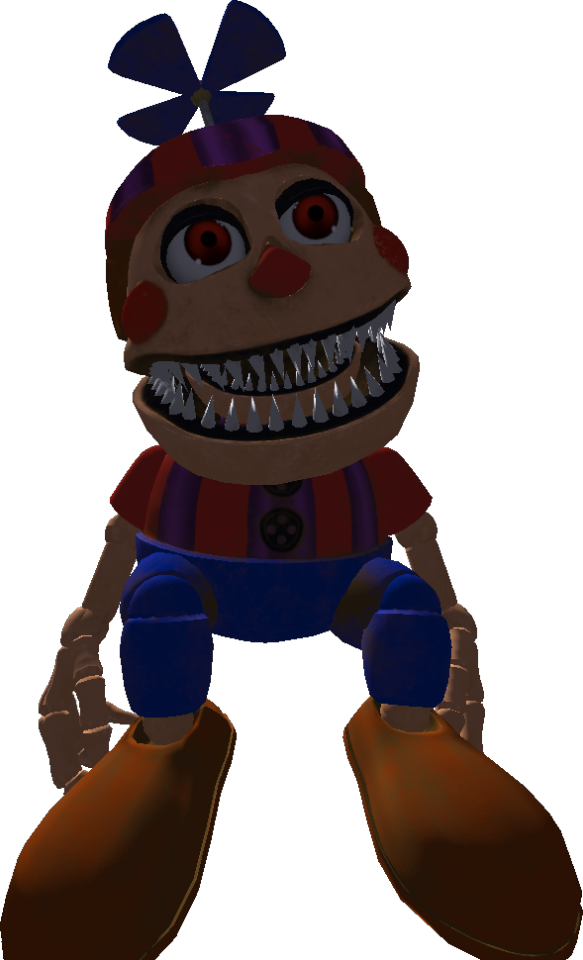
https://freddy-fazbears-pizza.fandom.com/wiki/Nightmare_Balloon_Boy#Gallery
To resemble the colors used in this game, a hex code like #414457 or #001d34 can be incorporated for the hallway. As for the enemy, any color that contrasts the dark tone of the hallway can work but some examples would include Plushtrap’s overall color like #484418 or a reddish color from Nightmare BB’s shirt like #5d1813. The enemy’s color shouldn’t be intensified to the point where the player can see them in the dark. Bright colors like yellow, white, and pink should be avoided unless the hue is lowered.
The textures in this setting is smooth but rounded especially when it comes to the inner hallway frames. As for the enemies themselves, Nightmare BB is also smooth to the touch with only some rounded edges around his joints. Plushtrap has a rubber or gritty texture on his body with only his teeth having a metallic smooth surface. The eroded design of Plushtrap gives off an “abandoned toy” look which is fitting for this game.

https://freddy-fazbears-pizza.fandom.com/wiki/Fun_with_Plushtrap
Shading is very heavy especially near the end of the hallway. As the hallway narrows, so does the lighting but when the flashlight is used the shading is focused more on the chair at the end of the hallway. The enemy, just like the chair, has some noticeable shading whenever the flashlight is shining on it. The shading gets slightly darker on Plushtrap or Nightmare BB the closer they are near the player.
The distance between the player and the end of the hallway is considerably close, leaving only the side hallways to act as an additional length for the enemy to hide. In Help Wanted, when using the VR headset, the distance between the ground and the ceiling is longer than the hallway itself leaving more space for the player to look around.

https://freddy-fazbears-pizza.fandom.com/wiki/Nightmare_Balloon_Boy#Gallery
Level of realism/exaggeration
In a realistic setting, this game would be unlikely however the 3D aspects make it slightly more convincing. This game exaggerates heavily on both the jump scare and lighting aspects and both together can give off an eerie or chilly vibe to the player. The lack of color and a simplistic setting allows the player to feel like they are unsafe even though it is only a video game. Despite the levels to be overall static, unless one plays the VR version, the game can still scare the player in a way especially when they are aware of the enemy’s presence. Their designs alone are childish but exaggerating their jaws and giving them a robotic structure can set off the unnerving tone of the game. Finally, the jump scares can be an exaggeration on their own since it is meant to be the selling point. In an artistic sense, when the enemy is closer the player will be able to see the rotted details of the enemies and the intimidating structures such as their sharp teeth and soulless eyes.

https://freddy-fazbears-pizza.fandom.com/wiki/Plushtrap
MDA Analysis
“Dark Rooms” are a series of Mini-game-type levels within the Five Nights at Freddy’s Help Wanted VR game. As the name implies the player will be put into a series of very dark rooms split between four different stages and then another four more challenging versions of the initial stages called “Blacklight mode”. With only a flashlight or flash beacon to light up a small portion of the room the player must survive and complete different objectives within each level.
Making the player have limited visibility is what really puts the tension on here as it becomes detrimental to the player to also overuse the light source putting either a time limit or death upon the player to prevent that. It makes the player confront their own fear to win, making them listen carefully to the audio ques coming from the pitch black before them as the only signal to react. On top of that each room has their own objectives and mechanics posed to the player to keep each encounter varied and challenging.
The first level which puts the player in a dark hallway across from “Plushtrap”, with your goal being to try and freeze it on top of a marked area. With 90 seconds to complete the objective, Plushtrap only moves in the dark and will be stopped in place when the player turns the flashlight onto it. What it comes down to is the players own timing and intuition as the goal marker is placed right in front of them, if you’re wrong on the timing only a little bit it will mean game over. With multiple rooms down the narrow hallway the challenge comes from distinguishing how close and what room Plushtrap is approaching from.
The second level is played exactly the same as the first however the key differences being a change in Plushtrap to the new enemy “Balloon Boy” who is much faster and offers fewer audio ques for the player making it a lot more difficult to stop him onto of the marked spot.
The third level of Dark Rooms places the player in what seems to be a prize room in the dark decayed remains of the Pizzeria. Now with a wider area your objective isn’t to just stop one single plush toy nightmare but many that will continually spawn all over the area. The objective now is to just survive until 6 AM (each hour about 30 seconds each), the series staple horror hours. “PlushBaby” will appear at random accompanied by audio ques of her own, but with a creepy factor turned to ten as she whispers to you from the dark corners of the room. The only way to ward her off is to shine your flashlight on her until she goes away. She can appear in multiple places at once and your light has a battery life this time, adding to the continued dread for the player, as if the battery dies, they will be unable to reuse the item until it has become fully charged again.
For the final and probably most horrifying level, the player is placed in a large maintenance type room with only a light beacon to see in small flashes. Placed with you in the room however is the wandering killer animatronic, Funtime Foxy. Using the beacon too much will cause you to become a target, but the player must use it to get their bearings on the area and move across the room to the exit. They must do this while also avoiding the ever present and constantly moving enemy. It is also important to note that the player is unable to truly explore the entire room or take wide curves around Foxy, instead only small areas of the map are marked in the okay and normal black checker tile. If the player steps on the red tiles that note an out of bounds they are automatically given a game over by a jump scare which makes the journey even more harrowing.
As mentioned before there is another aspect to this called Blacklight mode. These are essentially more difficult variations of the Dark Rooms with some key differences. The first level plays exactly like its counter part however the player’s size is reduced to that of what seems to be a small child. The second level, much like the first keeps the player small however the stage is now littered with balloons making it harder for the player to spot Balloon Boy as he approaches. The third level is when things get a bit hairier. All previous toys in the room are now replaced with inactive plushbabies making is much harder to discern the now more decrepit and decayed versions of Plushbaby which now haunt you with greater aggression. Finally, the last level forces the player to confront the maintenance room now filled with multiple clones of Foxy, Freddy, and Circus Baby all hunting for the player as they must traverse the room with only the small flashes of light to guide their way to safety.
Bartle Player Type Analysis
This game can appeal to a few different types of players. The first being Achievers, as they are determined to beat difficult challenges. This type of player will be drawn to the game’s different stages where they must survive with limited visibility and without getting jump-scared, which would end the game for them. Achievers are competitive and would love to see if they can finish all the levels and see if they can do it better or faster than other players. The mindset of the achievers would lead to a community of players dedicated to testing strategies and trying to beat the game with certain restraints for the achievements alone.
Explorers are players that enjoy exploring the world of the game. They like to find out the mechanics of the game, the possible short-cuts, and even tricks that they might find. They thrive in discovering more in the games they play. This type of player would be drawn in like the achievers will. They will want to learn everything they can about the game and its mechanics to min/max their play styles and times. The game will also draw the explorers that look into the lore and backstory of the game instead of the game mechanics. The FNAF series has a long list of characters and story that is hidden within the games.
Killers are players that are proud of their reputation & fighting skills for that reason this particular game may not appeal to them. As the player you don’t fight or actually kill anything, you just stand around and observe your surrounding and try not to get killed yourself.
Socializers are players that are proud of their friendships, contacts, & influence. FNAF is a single player game with no real socializing. You’re even alone in the game with only killer animatronics out to get you. For this reason I believe socializers may not enjoy this game.
Images and Gameplay


youtube
2 notes
·
View notes